A 3D model of NASA's New Horizons, a mission to Pluto and the Kuiper Belt.
Click and drag to rotate
Source: NASA Visualization Technology Applications and Development (VTAD)
Designed and integrated at the Johns Hopkins University Applied Physics Laboratory (APL) in Laurel, Maryland — with contributions from companies and institutions in the United States and abroad — the New Horizons spacecraft is a robust, lightweight observatory that has withstood the long, difficult journey from the launch pad on Earth to the solar system's coldest, darkest frontiers.
The New Horizons science payload was developed under direction of the Southwest Research Institute (SwRI), with instrument contributions from SwRI, APL, NASA's Goddard Space Flight Center, the University of Colorado, Stanford University and Ball Aerospace Corporation. Fully fueled, the agile, piano-sized probe weighed 478 kilograms (1,054 pounds) at launch. Designed to operate on a limited power source — a single radioisotope thermoelectric generator (RTG) — New Horizons needs less power than a pair of 100-watt light bulbs to perform its mission.
On average, each of the seven science instruments uses between 2 and 10 watts — about the power of a night light — when turned on. The instruments send data to the two onboard solid-state memory banks, where data are recorded before later playback to Earth. During normal operations, the spacecraft communicates with Earth through its 2.1-meter (83-inch) wide high-gain antenna. Smaller antennas provide backup communications. When the spacecraft was in hibernation through long stretches of its voyage, its computer was programmed to monitor its systems and report its status back to Earth with a specially coded, low-energy beacon signal.
New Horizons' "thermos bottle" design retains heat and keeps the spacecraft operating at room temperature without large heaters. Aside from protective covers on five instruments that were opened shortly after launch, and one small protective cover opened after the Jupiter encounter, New Horizons uses no deployable mechanisms or scanning platforms. It does have backup devices for all major electronics, its star-tracking navigation cameras and data recorders.
New Horizons has operated mostly in a spin-stabilized mode while cruising between planets, and also in a three-axis "pointing" mode that allows for pointing or scanning instruments during calibrations and planetary encounters (like the Jupiter flyby and, of course, at Pluto). Small thrusters in the propulsion system handle pointing, spinning and course corrections. The spacecraft navigates using onboard gyros, star trackers and Sun sensors. The spacecraft's high-gain antenna dish is linked to advanced electronics and shaped to receive even the faintest radio signals from home — a necessity when the mission's main target is more than 3 billion miles from Earth and light itself takes more than four and a half hours to go from Earth to the spacecraft.
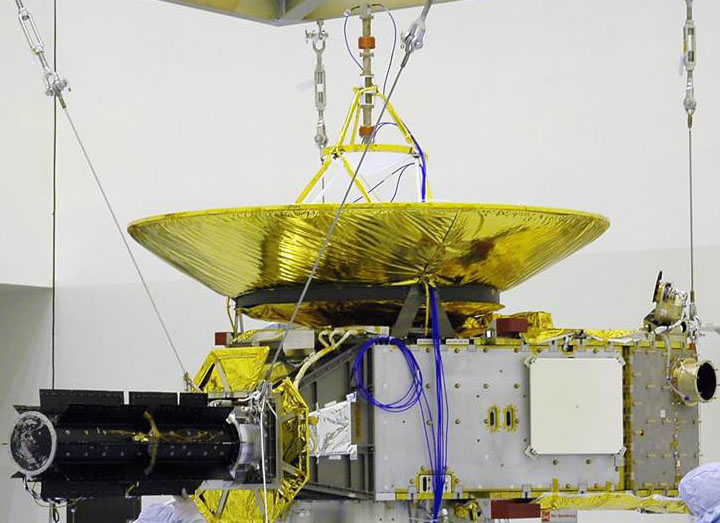
Structure
New Horizons' primary structure includes an aluminum central cylinder that supports the spacecraft body panels, supports the interface between the spacecraft and its RTG power source, and houses the propellant tank. It also served as the payload adapter fitting that connected the spacecraft to the launch vehicle.
Keeping mass down, the panels surrounding the central cylinder feature an aluminum honeycomb core with ultra-thin aluminum face sheets (about as thick as two pieces of paper). To keep it perfectly balanced for spinning operations, the spacecraft was weighed and then balanced with additional weights just before mounting on the launch vehicle.
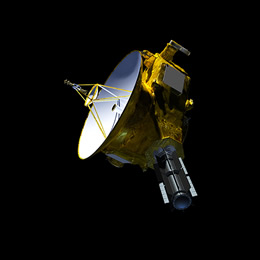
Command and Data Handling
The command and data handling system — a radiation-hardened 12-megahertz Mongoose V processor guided by intricate flight software — is the spacecraft's "brain." The processor distributes operating commands to each subsystem, collects and processes instrument data, and sequences information sent back to Earth. It also runs the advanced "autonomy" algorithms that allow the spacecraft to check the status of each system and, if necessary, correct any problems, switch to backup systems or contact operators on Earth for help.
For data storage, New Horizons carries two low-power solid-state recorders (one backup) that can hold up to 8 gigabytes each. The main processor collects, compresses, reformats, sorts and stores science and housekeeping (telemetry) data on the recorder — similar to a flash memory card for a digital camera — for transmission to Earth through the telecommunications subsystem.
The Command and Data Handling system is housed in an Integrated Electronics Module that also contains a vital guidance computer, the communication system and part of the REX instrument.
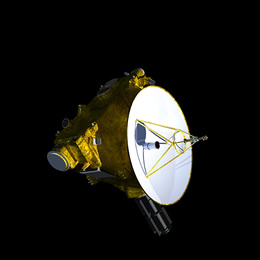
Thermal Control
New Horizons is designed to retain heat like a thermos bottle. The spacecraft is covered in lightweight, gold-colored, multilayered thermal insulation — like a survival camping blanket — which holds in heat from operating electronics to keep the spacecraft warm. Heat from the electronics has kept the spacecraft operating at between 10-30 degrees Celsius (about 50-85 degrees Fahrenheit) throughout the journey.
New Horizons' sophisticated, automated heating system monitors power levels inside the craft to make sure the electronics are running at enough wattage to maintain safe temperatures. Any drop below that operating level (about 150 watts) and it will activate small heaters around the craft to make up the difference. When the spacecraft was closer to Earth and the Sun, louvers (essentially heat vents) on the craft opened when internal temperatures were too high.
The thermal blanketing — 18 layers of Dacron mesh cloth sandwiched between aluminized Mylar and Kapton film — also helps to protect the craft from micrometeorites.
Propulsion
The propulsion system on New Horizons is used for course corrections and for pointing the spacecraft. It was not needed to speed the spacecraft along its trajectory to Arrokoth and beyond; that was done by the launch vehicle, with a boost from Jupiter's gravity. But it does make small corrections to the flight path and tiny changes to the speed to ensure that New Horizons arrives when and where it can make the best observations. For example, after the Pluto encounter, it changed the trajectory very slightly to go to Arrokoth.
The New Horizons propulsion system includes 16 small hydrazine-propellant thrusters mounted across the spacecraft in eight locations, a fuel tank, and associated distribution plumbing. Four of these thrusters, each of which provides 4.4 Newtons (1 pound) of force are used for course corrections. Operators also employ 12 smaller thrusters — each providing 0.8 Newtons (about 3 ounces) of thrust each — to point, spin up and spin down the spacecraft. Eight of the 16 thrusters aboard New Horizons are considered the primary set; the other eight comprise the backup (redundant) set.
At launch, the spacecraft carried 77 kilograms (170 pounds) of hydrazine, stored in a lightweight titanium tank. Helium gas pushes fuel through the system to the thrusters. The Jupiter gravity assist, and the mission design calling for flybys at Pluto and Arrokoth (instead of entries into orbit), reduced the amount of propellant needed for the mission.
Guidance and Control
New Horizons must be oriented precisely to collect data with its scientific instruments, communicate with Earth, or maneuver through space.
Attitude determination — knowing which direction New Horizons is facing — is performed using star-tracking cameras, Inertial Measurement Units (IMUs) (containing sophisticated gyroscopes and accelerometers that measure rotation and horizontal/vertical motion), and digital Sun sensors. Attitude control for the spacecraft — whether in a steady, three-axis pointing mode or in a spin-stabilized mode — is accomplished using thrusters.
The IMUs and star trackers provide constant positional information to the spacecraft's Guidance and Control processor, which like the Command and Data Handling processor is a 12-MHz Mongoose V. New Horizons carries two copies of each of these units for redundancy. The star-tracking cameras store a map of about 3,000 stars; 10 times per second one of the cameras snaps a wide-angle picture of space, compares the locations of the stars to its onboard map, and calculates the spacecraft's orientation. The IMU measures spacecraft angular rates 100 times a second. If data shows New Horizons is outside a predetermined position, small hydrazine thrusters will fire to reorient the spacecraft. The Sun sensors back up the star trackers; they would find and point New Horizons toward the Sun (with Earth nearby) if the other sensors couldn't find home in an emergency.
Operators use thrusters to maneuver the spacecraft, which has no internal reaction wheels. Its smaller thrusters are used for fine pointing; thrusters that are approximately five times more powerful are used during the trajectory course maneuvers that guide New Horizons toward its targets. New Horizons spins — typically at 5 revolutions per minute (RPM) — during trajectory-correction maneuvers and long radio contacts with Earth, and while it "hibernates" during long cruise periods. Operators steady and point the spacecraft during science observations and instrument-system checkouts.
Communications
Accurate Ranging:
New Horizons is the first mission to use onboard regenerative ranging to track the distance between the spacecraft and Earth. When a spacecraft is far from home, the ranging tone sent from the ground to measure distance is weak (or "noisy") by the time it reaches the spacecraft's communications system. In normal ranging, the spacecraft simply amplifies and sends the noisy tone back to Earth, which adds errors to the range measurement. In regenerative ranging, the spacecraft's advanced electronics track and "regenerate" the tone without the noise. The ground station on Earth receives a much clearer signal — giving navigators and operators a more accurate lock on the spacecraft's distance, and improving their ability to guide New Horizons through the solar system.
New Horizons' X-band communications system is the spacecraft's link to Earth, returning science data, exchanging commands and status information, and allowing for precise radiometric tracking through NASA's Deep Space Network of antenna stations.
The system includes two broad-beam, low-gain antennas on opposite sides of the spacecraft, which were used early in the mission for near-Earth communications; as well as a 30-centimeter (12-inch) diameter medium-gain dish antenna and a large, 2.1-meter (83-inch) diameter high-gain dish antenna. The antenna assembly on the spacecraft's top deck consists of the high, medium, and forward low-gain antennas; this stacked design provides a clear field of view for the low-gain antenna and structural support for the high and medium-gain dishes. Operators aim the antennas by turning the spacecraft toward Earth. The high-gain beam is only 0.3 degrees wide, so it must point directly at Earth. The wider medium-gain beam (4 degrees) is used in conditions when the pointing might not be as accurate. All antennas have Right Hand Circular and Left Hand Circular polarization feeds.
Data rates depend on spacecraft distance, the power used to send the data and the size of the antenna on the ground. For most of the mission, New Horizons has used its high-gain antenna to exchange data with the Deep Space Network's largest antennas, 70 meters across. Even at Arrokoth, because New Horizons was be more than 4 billion miles from Earth and radio signals took more than six hours to reach the spacecraft, it was able to send information at about 1,000 bits per second.
New Horizons is flying the most advanced digital receiver ever used for deep space communications. Advances include regenerative ranging and low power — the receiver consumes 66% less power than earlier deep-space receivers. The Radio Science Experiment (REX) that examined Pluto's atmosphere is also integrated into the communications subsystem.
The entire telecom system on New Horizons is redundant, with two of everything except the high-gain antenna structure itself.
Power
New Horizons' electrical power comes from a single radioisotope thermoelectric generator (RTG). The RTG provides power through the natural radioactive decay of plutonium dioxide fuel, which creates a huge amount of heat. Unlike a normal reactor, the Plutonium-238 used in the RTG cannot undergo a chain reaction. But, its normal decay rate is high enough (that is, its half-life is short enough) that it always releases heat at a high rate. That heat is converted directly to electrical power by thermocouples.
The New Horizons RTG, provided by the U.S. Department of Energy, carries approximately 11 kilograms (24 pounds) of plutonium dioxide. Onboard systems manage the spacecraft's power consumption so it doesn't exceed the steady output from the RTG, which has decreased by about 3.5 watts per year since launch.
Typical of RTG-based systems, as on past outer-planet missions, New Horizons does not have a battery for storing power.
At the start of the mission, the RTG supplied approximately 245 watts (at 30 volts of direct current) — the spacecraft's shunt regulator unit maintains a steady input from the RTG and dissipates power the spacecraft cannot use at a given time. By January 2019 (when New Horizons flew past Arrokoth) that supply decreased to about 190 watts at the same voltage, so New Horizons eased the strain on its limited power source by cycling science instruments during the encounter.
The spacecraft's fully redundant Power Distribution Unit (PDU) — with 96 connectors and more than 3,200 wires — efficiently moves power through the spacecraft's vital systems and science instruments.
A description of the RTG power system on New Horizons mission and the final EIS can be found below:
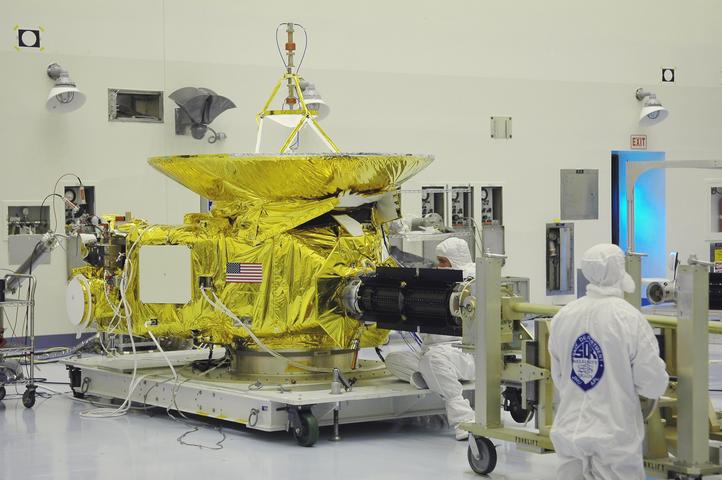
Read about the radioisotope power systems that enabled some of NASA's greatest voyages »
Flying with an RTG
How hot is the RTG? Sensors attached to the outside of the RTG case before launch pegged the case temperature at about 245 C (nearly 475 F). When New Horizons reaches Pluto, engineers estimate the temperature will have dropped to around 208 C (406 F) — thanks to a combination of distance from the Sun and fuel decay.
The RTG is not hot enough to produce visible light, but it does emit infrared (or thermal) radiation.
At launch the fuel produced almost 4,000 watts of thermal power; of that, New Horizons used about 25 watts of the waste heat to warm the spacecraft. Electrical power output of the RTG was about 245 watts. Some of that electrical power (about 120 watts) is also reused after powering components to help heat the spacecraft. The rest of the RTG heat and any extra electrical power are radiated into space.
Many scientific instruments work better when they are cold; that's one reason why they are located on the opposite side of the spacecraft from the RTG. New Horizons also has a heat shield around the base of the RTG to avoid a direct line of sight from the instruments to the RTG. These design features help avoid any interference from the RTG with scientific measurements.
Nuclear Safety Issues and Answers
Introduction
The Final Environmental Impact Statement for the mission was released to the public on Aug. 5, 2005. NASA issued its National Environmental Policy Act (NEPA) record of decision for New Horizons on Sept. 7, 2005 - deciding to complete preparations for launch in January-February 2006, and to operate the mission. The White House Office of Science Technology Policy gave approval for the launch to proceed.
An appendix in the Final EIS includes public comments on the Draft Environmental Impact Statement, gathered during a 45-day period from February-April 2005, and during two community meetings in Cocoa, Florida, in March 2005.
Final Environmental Impact Statement
Disclaimer: While the National Aeronautics and Space Administration (NASA) has taken reasonable and prudent measures to ensure the accuracy, integrity and security of the electronic version of the Final Environmental Impact Statement for the New Horizons mission, NASA cannot guarantee that the electronic version is identical to the printed version, nor that it cannot be tampered with by a third party.
Download the document (PDF) in two sections:
The Draft Environmental Impact Statement is also available here.
Draft Environmental Impact Statement
Disclaimer: While the National Aeronautics and Space Administration (NASA) has taken reasonable and prudent measures to ensure the accuracy, integrity and security of the electronic version of the Draft Environmental Impact Statement for the New Horizons mission, NASA cannot guarantee that the electronic version is identical to the printed version, nor that it cannot be tampered with by a third party.
or as separate sections below:
- Front Section (691 KB)
Abstract, Executive Summary, Table of Contents, and Chapter 1 (Purpose and Need for the Action)
- Chapter 2 (2.4 MB)
Description and Comparison of Alternatives
- Chapter 3 (2.5 MB)
Description of the Affected Environment
- Back Section (650 KB)
Chapter 4 (Environmental Consequences), Chapter 5 (List of Preparers), Chapter 6 (Agencies, Organizations and Individuals Consulted), Chapter 7 (Index), and Chapter 8 (References)
- Appendices (647 KB)
Appendix A (Glossary of Terms), Appendix B (Effects of Plutonium of the Environment), and Appendix C (Environmental Justice Analysis)
Public Involvement
Comments
On Feb. 25, 2005, the U.S. Environmental Protection Agency's notice of availability for the New Horizons Draft Environmental Impact Statement was published in the Federal Register. Interested parties had 45 days to submit written or electronic comments on environmental concerns on the Draft Environmental Impact Statement; these comments had to be postmarked on or before April 11, 2005.
The Final Environmental Impact Statement was released to the public in August 2005; an appendix in the Final EIS includes public comments on the Draft EIS and NASA's responses. NASA issued its National Environmental Policy Act (NEPA) record of decision for New Horizons on Sept. 7, 2005 — deciding to complete preparations for launch in January-February 2006, and to operate the mission. The White House Office of Science and Technology Policy approved the launch in January 2006.
Public Meetings
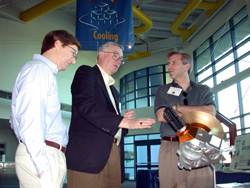
On March 29-30, 2005, NASA hosted meetings during which the public was invited to participate in an open exchange of information and to submit comments on the New Horizons Draft Environmental Impact Statement. Each public meeting began with an opportunity for informal discussions with project personnel, followed by a brief NASA presentation on the New Horizons mission, and concluded with an invitation to attendees to ask questions or submit formal comments.
The meetings were held at the Florida Solar Energy Center in Cocoa, Florida. Click on a presenter's name to see an individual presentation, or click here for the full presentation.

- Kurt Lindstrom, program executive, NASA Headquarters: mission overview
- Hal Weaver, project scientist, Johns Hopkins Applied Physics Laboratory: mission science
- Glen Fountain, project manager, Johns Hopkins Applied Physics Laboratory: mission design
- Kurt Lindstrom, program executive: Draft EIS overview
- Kenneth Kumor, NASA Headquarters: National Environmental Policy Act (NEPA) process
NASA included comments received during the meeting - and during the public comment period - in the Final Environmental Impact Statement.
Schedule







